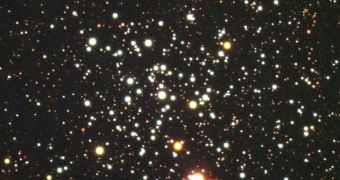Iota Horologii is a yellow-orange star, located about 56 light-years away from Earth, in the Horologium constellation, and one of a large population of stars drifting through the Milky Way in the same general direction. New observations conducted with the help of one of ESO's 3.6 meter telescopes proved that in fact Iota Horologii is moving away from the Hyades star cluster. Previous studies of the star revealed that it is orbited by a planet about twice the size of Jupiter, which completes a rotation around it in roughly 320 days.
However, all other previous studies failed to show what the origin of the star is. By implying a technique known as 'asteroseismology', a team of researchers from University of Touluse, led by Sylvie Vauclair, finally revealed the star's birthplace.
"In the same way as geologists monitor how seismic waves generated by earthquakes propagate through the Earth and learn about the inner structure of our planet, it is possible to study sound waves running through a star, which forms a sort of large, spherical bell," says Vauclair.
Eight consecutive nights of observation during November 2006 identified 25 different waves, most of which having a period of 6.5 minutes, thus revealing that Iota Horologii is a 625 million year old star, with a mass 1.25 times that of the Sun, a surface temperature of 6150 Kelvin and a metallicity 50 percent higher than that of our own star.
"These results show the power of asteroseismology when using a very precise instrument such as HARPS. It also shows that Iota Horologii has the same metal abundance and age as the Hyades cluster and this cannot be a coincidence," said Vauclair.
The Hyades star cluster is located about 151 light years away from Earth, has a relatively high metallicity and contains stars that formed about the same time, some 625 million years ago. You can see it with the naked eye towards the Taurus constellation. If astronomers are correct in their presumption, Iota Horologii is currently at a distance of 130 light years from its birthplace. This would explain why the star appears to have such a high metallicity, opposed to the belief that it was determined by the star swallowing high amounts of planetary material.
"The chicken and egg question of whether the star got planets because it is metal-rich, or whether it is metal-rich because it made planets that were swallowed up is at least answered in one case," says Vauclair.

 14 DAY TRIAL //
14 DAY TRIAL //